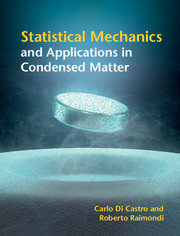Book contents
- Frontmatter
- Contents
- Preface
- 1 Thermodynamics: a brief overview
- 2 Kinetics
- 3 From Boltzmann to Boltzmann–Gibbs
- 4 More ensembles
- 5 The thermodynamic limit and its thermodynamic stability
- 6 Density matrix and quantum statistical mechanics
- 7 The quantum gases
- 8 Mean-field theories and critical phenomena
- 9 Second quantization and the Hartree–Fock approximation
- 10 Linear response and the fluctuation–dissipation theorem in quantum systems: equilibrium and small deviations
- 11 Brownian motion and transport in disordered systems
- 12 Fermi liquids
- 13 The Landau theory of second order phase transitions
- 14 The Landau–Wilson model for critical phenomena
- 15 Superfluidity and superconductivity
- 16 Scaling theory
- 17 The renormalization group approach
- 18 Thermal Green functions
- 19 The microscopic foundations of Fermi liquids
- 20 The Luttinger liquid
- 21 Quantum interference effects in disordered electron systems
- Appendix A The central limit theorem
- Appendix B Some useful properties of the Euler Gamma function
- Appendix C Proof of the second theorem of Yang and Lee
- Appendix D The most probable distribution for the quantum gases
- Appendix E Fermi–Dirac and Bose–Einstein integrals
- Appendix F The Fermi gas in a uniform magnetic field: Landau diamagnetism
- Appendix G Ising and gas-lattice models
- Appendix H Sum over discrete Matsubara frequencies
- Appendix I Two-fluid hydrodynamics: a few hints
- Appendix J The Cooper problem in the theory of superconductivity
- Appendix K Superconductive fluctuation phenomena
- Appendix L Diagrammatic aspects of the exact solution of the Tomonaga–Luttinger model
- Appendix M Details on the theory of the disordered Fermi liquid
- Appendix N Answers to problems
- References
- Index
17 - The renormalization group approach
Published online by Cambridge University Press: 05 September 2015
- Frontmatter
- Contents
- Preface
- 1 Thermodynamics: a brief overview
- 2 Kinetics
- 3 From Boltzmann to Boltzmann–Gibbs
- 4 More ensembles
- 5 The thermodynamic limit and its thermodynamic stability
- 6 Density matrix and quantum statistical mechanics
- 7 The quantum gases
- 8 Mean-field theories and critical phenomena
- 9 Second quantization and the Hartree–Fock approximation
- 10 Linear response and the fluctuation–dissipation theorem in quantum systems: equilibrium and small deviations
- 11 Brownian motion and transport in disordered systems
- 12 Fermi liquids
- 13 The Landau theory of second order phase transitions
- 14 The Landau–Wilson model for critical phenomena
- 15 Superfluidity and superconductivity
- 16 Scaling theory
- 17 The renormalization group approach
- 18 Thermal Green functions
- 19 The microscopic foundations of Fermi liquids
- 20 The Luttinger liquid
- 21 Quantum interference effects in disordered electron systems
- Appendix A The central limit theorem
- Appendix B Some useful properties of the Euler Gamma function
- Appendix C Proof of the second theorem of Yang and Lee
- Appendix D The most probable distribution for the quantum gases
- Appendix E Fermi–Dirac and Bose–Einstein integrals
- Appendix F The Fermi gas in a uniform magnetic field: Landau diamagnetism
- Appendix G Ising and gas-lattice models
- Appendix H Sum over discrete Matsubara frequencies
- Appendix I Two-fluid hydrodynamics: a few hints
- Appendix J The Cooper problem in the theory of superconductivity
- Appendix K Superconductive fluctuation phenomena
- Appendix L Diagrammatic aspects of the exact solution of the Tomonaga–Luttinger model
- Appendix M Details on the theory of the disordered Fermi liquid
- Appendix N Answers to problems
- References
- Index
Summary
As discussed in the previous chapter, the phenomenological theory of critical phenomena finds a sound basis in the logical sequence of universality, scaling, relevant and irrelevant variables. The difficult problem of a large number of degrees of freedom strongly correlated within the coherence distance, which diverges at criticality, is thereby, in principle, reduced to the determination of the homogeneous form of the relevant response functions and of the evaluation of a few critical indices related to the relevant parameters, whereas the details specifying each system do not matter.
In order to give a microscopic foundation to universality and to the scaling theory, an exact transformation is needed, which changes into a scaling transformation asymptotically near the critical point. This is the renormalization group (RG) approach, recently presented in a huge number of reviewpapers and books.Historically, the first comprehensive overview was given by the sixth volume of the series edited by Domb and Green (1976) and by the classic books by Patashinskij and Pokrovskij (1979) and by Ma (1976).
Along with scaling theory, the field-theoretic renormalization group (RG) approach (Gell- Mann and Low (1954); Bogoliubov and Shirkov (1959); Bonch-Bruevich and Tyablikov (1962)) was introduced in critical phenomena (Di Castro and Jona-Lasinio (1969)) by showing how the RG equations generalize the universality relations in the sense that they relate one model system to another by varying the coupling and suitably rescaling the other variables and the correlation functions. At the same time a detailed analysis of the pertubative diagrammatic structure of the correlation functions together with the use of Ward identities yielded a renormalized theory (Migdal (1969); Polyakov (1968, 1969)). By iterating the RG transformation the coupling disappears from the equations near to the critical point, the homogeneous form of the static order-parameter correlation function is obtained and a microscopic definition of the critical indices is given. The scaling picture then acquires a theoretical basis.
Wilson (Wilson (1971a, b); Wilson and Kogut (1974)) gave a great contribution to the understanding of the physics underlying the RG procedure and to the explicit calculation of the critical indices. He proposed a simple mathematical realization of the other very physical idea of universality due to Kadanoff of grouping together degrees of freedom on the scale s associated with larger and larger cells.
- Type
- Chapter
- Information
- Statistical Mechanics and Applications in Condensed Matter , pp. 290 - 317Publisher: Cambridge University PressPrint publication year: 2015



